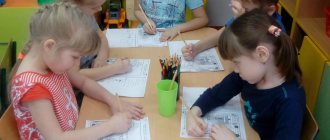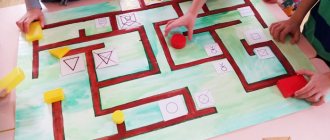Communication as a condition for meeting the needs of a preschooler
Before a child develops the need to communicate with others, he reaches out to others for the sake of comfortable sensations, for the sake of gaining security, for the sake of receiving impressions. These needs appear from the first days of life.
By the age of 3, cognitive needs come to the fore. Where can she be satisfied if not by turning to an adult?
Kids need to make so many discoveries and understand how this world works that they constantly need explanations and help from parents, educators, and older brothers and sisters.
Younger preschoolers not only ask questions. They strive to express their Self. They need to address it to someone: “I myself!” Or draw the attention of the same children to yourself, saying “These are my toys”, “Look what doll they gave me.” For such self-affirmation, viewers, listeners, and partners are needed. Communication provides them.
By the age of five, the need for respect is formed. Children demonstrate what they have already learned and what they know or can do. When communicating with peers, edifying phrases are often heard: “Look how you should do it,” “Do it as I do!” In addition, in middle preschool age, boys and girls need equal play partners. Children's games are nothing more than an organized form of communication.
For older preschoolers, the need to talk about their impressions, convey interesting information and establish their authority among their peers is becoming more urgent. Therefore, their communications cover an increasingly larger circle of peers. Preschoolers are already good at identifying moral qualities, so they are drawn to those peers who are closer to them.
We have provided a small list of needs that preschoolers satisfy in communicating with others.
Communications that arise on the basis of certain needs, motives, as well as the verbal and non-verbal means used, form stable forms of communication.
For children, almost all interactions are tied to specific situations. With growing up, forms of communication in preschoolers develop, and they acquire an extra-situational character.
The concept of pedagogical communication
Ped. communication is a dialogue between a teacher and students or pupils that has a professional orientation. This form of teaching or education is necessary to create a favorable psychological atmosphere in the team, so that the presentation of material is not a dry listing of facts.
The teacher gives the basics of communication
For your information! With such communication, children perceive information coming from an adult more readily.
Although it should be borne in mind that much depends on the personality of the teacher. Childcare should be as positive and friendly as possible, but with elements of a certain severity to maintain discipline in the children's team.
Dialogue with children is conducted competently
Heuristic conversation as a teaching method
In pedagogy, heuristic pedagogical communication is teaching in the form of question and answer. It was created by Socrates in Ancient Greece two thousand years ago. In the mid-50s of the last century, heuristic conversation became the subject of active study, since it was inherently well suited for solving issues of teaching children with special needs.
As a result, a system of certain techniques was developed, which made it possible to apply it in types of communication between an adult and a preschool child.
The essence of a heuristic conversation is that the teacher does not present ready-made knowledge and solutions to the problem, but pushes his interlocutors to the right solution through correctly posed additional questions.
For your information! Each answer to such an additional question is a step towards the correct answer to the main question. All leading questions are interconnected by a common theme and follow from one another.
Moreover, each such question is asked not mechanically, but during a conversation between the teacher and preschoolers, the topic of which is the problem raised.
With this form of communication, the teacher’s ability to conduct a conversation and encourage his students to engage in it until the main goal is achieved is most clearly demonstrated.
How do preschoolers communicate with others?
If we briefly consider how forms of communication progress in preschool age, then it is best to turn to the work of the famous psychologist M.I. Lisina, who identified four levels of communication from infancy to 7 years, designating them as a form:
- Situational-personal
- Situational business
- Extra-situational-cognitive
- Extra-situational-personal
The first ones in this list are formed earlier, based on specific actions, objects, and experiences. By older preschool age, they do not disappear, but partially give way to more developed forms that are not tied to the situation. These changes are facilitated by the development of children's speech and verbal-logical thinking.
The highest form of communication for preschool age is one that promotes understanding of the meaning of human relationships, as well as the assimilation of the norms and values of society. Consequently, this is an extra-situational-personal form of communication.
Forms of communication between preschoolers and peers
In the period from 3 to 7 years, forms of communication with peers are observed, which are consistently updated from younger to older preschool age:
- Emotional-practical
- Situational business
- Non-situational business
Communication among younger preschoolers is stimulated by emotions or practical action. Kids can simply run up to each other with a joyful smile, and this is already a sign that they are interested in communicating. It is not so important how long their communication will captivate them. The emotionality of contact is valuable.
The children's joint actions are still short-lived. They can make Easter cakes nearby or roll cars. They can demonstrate how far they throw a ball or slide down a slide. However, the emotional-practical form of communication provides the basis for the formation of initiative in communication.
In middle preschool age, children's business communication actively develops. This is due to the fact that the role-playing game progresses story-wise. Preschoolers no longer play just side by side, but together, choosing more complex plots, distributing roles, and agreeing on the rules.
Some business qualities are demonstrated, but they are tied to situations. For example, a child may act as a strict controller in the game in accordance with the chosen role, but behave timidly in ordinary contacts.
Extra-situational relationships allow you to shift attention from the actions of the communication partner to the person himself. Unexpectedly, the preschooler begins to see his play partner as an interlocutor, a person with his own interests and preferences. Another thing is that the revealed personality traits can either please or repel. Both a boy and a girl can tell their yesterday’s friend that they no longer play with him, because he takes other people’s toys without permission, offends others, etc.
Among children, a preschooler acquires behavioral skills, learns mutual understanding, and discovers social values.
The behavior of peers serves as a kind of mirror, allowing the child to see himself from the outside. And developing social intelligence helps the preschooler to notice the nuances of facial expressions and statements that previously escaped attention.
The basis for organizing communication between preschool children
Definition 1
Communication is a specific form of human interaction with other people as members of society.
The basis of communication from a psychological and pedagogical point of view is a personal approach, which is focused on the comprehensive development of the child’s personality, as well as on his interaction with other children in the framework of various types of activities (educational, work, play, etc.). Reliance on this method is due to its systematic nature.
Definition 2
The psychological and pedagogical foundations of communication among preschool children is one of the new disciplines, representing a set of theoretical developments and experimental studies that provide a great opportunity for understanding the development of a child’s personality.
Are you an expert in this subject area? We invite you to become the author of the Directory Working Conditions
Based on this definition, the psychological and pedagogical foundations of communication are represented by two lines - theory and practice (experiment).
The theoretical line of the psychological and pedagogical basis of communication represents the rationale for the basic type of activity within which interaction takes place between the teacher and students.
The second line is experimental (practical), based on the parameters of interpersonal interaction, which includes three main components: cognitive, behavioral and affective (emotional).
Forms of communication between children and adults
Communication with adults is, in essence, interactions in the “zone of proximal development,” since a preschooler uses his potential and fills in the blank spots in his knowledge.
Starting from the age of 3, the baby becomes an active explorer of everything around him.
The need for cognitive activity and the desire to get answers to puzzling questions directs him to his parents or other significant adults. Interaction takes on an extra-situational character and is realized in two forms of communication that follow each other.
Extra-situational-cognitive communicative form
Communication can be situational in nature, and the child may ask to draw the same bunny that he has in his hands. But increasingly, interest goes beyond situations. The preschooler asks where the bunny lives, if he has a house, and immediately continues to ask questions about all the animals he knows.
An adult is an expert for a child who knows everything and can do everything. The kid accepts any answer. Often these answers are presented in a fantasy or fairy tale context. And how else can a child answer the question in style, does the Bear sing songs to her Little Bear?.. Nevertheless, the preschooler satisfies his current cognitive interest.
Cognitive communication with an adult gives the child real ideas about the world and expands his understanding of the cause-and-effect relationships between surrounding objects and phenomena.
Extra-situational-personal form of communication
The older a preschooler gets, the more he understands that the social environment is much wider and more diverse than his usual environment. The child realizes that he needs to learn how to behave and act correctly in different situations. Moreover, he sees the different behavior of his peers, which leads him to the conclusion that not everyone behaves as they should.
The preschooler has questions for elders in order to understand the meaning of relationships between people. To some extent, the older preschooler checks his point of view to see whether it coincides with the position of the adult. This is how generally accepted social norms are assigned.
By talking with adults, the child learns standards of expression and behavioral cultural norms. The preschooler begins to develop his own authorities. To understand a certain situation, he increasingly turns to the adult whom he considers most competent in this matter.
Article:
The effectiveness of organizing children's communication is determined by the combination of the following conditions:
comprehensive diagnostics of the development of communication in preschoolers, allowing for a differentiated approach, choosing the optimal forms and content of developmental education (diagnostic analytical conditions);
- ensuring the gradual development of communication, subject to the gradual complication of communicative activities, emotional saturation of the content and procedural aspects of developmental education based on the leading - gaming activity (organizational and content conditions);
- active participation of the entire teaching staff and parents in ensuring the communicative orientation of teaching and raising children, promoting the development of partnership in various types of activities (communication, play, learning); models and situations of communication; mastering by preschoolers the means and age-specific forms of communication; normalization of non-speech processes (communicative and gaming conditions).
In addition, educators should strive to create a favorable emotional climate in the group, help children, and establish positive relationships. Experience shows that in groups of even the youngest children, where teachers pay special attention to their communication, the children are cheerful, quarrel little, love to watch their peers play, and know how to play next to or with each other.
The most important condition for raising positive relationships is the attitude of adults towards children. If a teacher rudely pulls a naughty child back, talks to him in a raised tone, makes harsh remarks, gives offensive nicknames; forcefully pulls apart those who have quarreled; this style of behavior will be involuntarily adopted by him in relation to his peers. Therefore, first of all, adults demonstrate by their own example examples of friendly relationships with children.
The combination of working with the group as a whole and individual communication with each is a necessary condition for creating a warm atmosphere of mutual understanding in the group and trusting relationships between children.
The work of a teacher with children in a group involves solving the following tasks:
- attracting children's attention to each other, supporting their interest in peers;
- stimulating emotional contacts between peers, bringing them closer to each other;
- organization of substantive interaction between children.
To encourage children to communicate with peers, a variety of situations in their life should be used: routine moments, free play, group activities, specially organized games.
Organizing communication between children during the day. The good mood of the children and their goodwill towards each other must be maintained from the moment they arrive at the nursery. To achieve this, the teacher invites the kids to say hello to each other, calling each child by name, draws their attention to how beautifully they are dressed, how they know how to take off their jacket, boots, etc. Older children can be asked to help a peer put his clothes in the locker, Join the group together. If there are already children in the group room, the teacher draws their attention to the newcomer, encourages them to say hello to him. It is good to introduce a ritual of farewell to children before going home: say “goodbye”, wave your hand.
During routine moments, the teacher draws the children’s attention to how each of them eats well, washes themselves cleanly, carefully makes their crib, and encourages the children to wish everyone a good night’s sleep. To maintain children's interest in each other, it is good to use play techniques, reading nursery rhymes, singing songs, mentioning the name of each child in them and encouraging him to repeat them.
In order for children to learn to understand each other better, to develop a sense of community with their peers, it is necessary to draw the child’s attention to the fact that the other baby is just like him: he also has eyes and hands, he can talk, run, look, play.
From a very early age, it is necessary to cultivate in them a respectful attitude towards other children, regardless of race and nationality, language, personal and behavioral identity (including appearance, physical disabilities, etc.). If there are children of different nationalities in the group, it is necessary to ensure that the kids do not tease them and are tolerant of their speech deficiencies, i.e. It is necessary to cultivate a tactful attitude, encourage the expression of sympathy, and the desire to help.
One of the important components of human communication is eye contact. Children who cannot and do not want to communicate rarely look into each other’s faces and eyes. Their attention is focused mainly on how their peer is playing. Therefore, children often do not remember their peers in the group, do not recognize them, and do not develop selective attachments. It is advisable to organize such situations when the teacher places two or three children next to him and, while talking with one of the children, draws the attention of others to him, inviting him to look him in the face, in the eyes, and call him by name. You just have to keep in mind that you can’t force kids to communicate with each other.
A good technique for bringing children together is to look at children’s work together: drawings, plasticine figures, buildings made of cubes, etc. An adult gathers several children around him and, in their presence, praises each one, encouraging others to praise him.
The creation of friendly relationships between children is also facilitated by jointly looking at children's photographs, talking about the parents of the children, celebrating the birthday of each child, and jointly making simple gifts for the birthday boy.
A necessary condition for awakening and maintaining good relationships between children is to attract their attention to each other’s emotional states. The teacher encourages children to rejoice at their peers, show sympathy, and pity. At the same time, it is important to avoid coercion, not to force children to do something against their will, or to tear them away from classes.
An emotionally positive atmosphere maintained by the teacher during the day will help children get to know each other better and will contribute to the establishment of friendly relationships between them.
Episodes of joint observation of various events and phenomena that naturally arise during the day, organized by the teacher, can serve to bring children together. For example, looking at fish in an aquarium, watching how a cat washes itself on the path outside the window, how a bird builds a nest in a tree, how a car drives, it rains, children walk, etc. The teacher offers to look at all this together, asks questions, answers the kids' questions, and if the children can speak, encourages them to tell their peers about what they saw:.
Conflicts often arise between young children. They can quarrel over toys, because of the attention of an adult, and sometimes show unmotivated aggression (biting, pinching, scratching).
Children's conflicts can be caused by various reasons, but the main thing is the child's desire to communicate with adults and to examine objects. At first, a peer is often perceived by the child as a “disturbance” in the realization of these aspirations or as an object of interest for research. When children try to do things together, they lack the skills to interact with an equal partner.
Most often, when they quarrel over a toy, adults resort to disciplinary measures: they scold, demand that the toy be returned to the owner, and take it away from both; if push comes to shove, the kids are separated or punished. Such methods of influence, although they allow you to quickly stop a quarrel, at the same time: do not exhaust the conflict. Children can harbor a grudge for a long time, which, as a rule, leads to subsequent aggressive actions and refusal to communicate with adults and peers. As a result, they acquire negative experience in resolving conflict situations by force, and a tense emotional atmosphere is established in the group.
Adult influence can only be truly effective when it is aimed at teaching children positive ways to resolve conflicts. The teacher should try to resolve conflicts in a gentle form, without violence and shouting, by transforming them into positive forms of interaction, switching attention to other activities or objects. The teacher can:
- distract the attention of one of the children with another toy, an interesting activity, or offer him the same one;
- organize a joint game with the toy that caused the conflict;
- help children establish turns in playing with the same toy.
At the same time, it is very important that adults do not allow elders and more
the strong to offend the smaller and weaker.
When choosing one option or another, you should take into account the age and individual characteristics of children (ability to play, use speech,
accept the rules of turn), the degree of emotional intensity of the conflict. In a fairly calm situation, it is advisable to offer a joint game or establish a turn, while explaining that it is not. offend each other, you need to give in, etc. An adult should help discuss the situation, formulate their desires, and come to an agreement.
Some features of personal communication
The desire to communicate with adults largely depends on the personal expectations of the preschooler. If a child has a predominantly positive experience of previous contacts with specific adults, he is drawn to them. Conversely, negative impressions cancel out the desire to communicate. Some grandmothers wonder why their grandchildren are so reluctant to visit them. They don’t even notice how zealously they protect the inviolability of their shelves, how strictly they reprimand the child when he violates the usual order in their apartment.
Personally, a preschooler needs warm emotional connections and adults to be interested in him, his activities and skills. The child expects support and empathy, he is sensitive to praise. This does not mean that children should be praised. But there will always be achievements worth celebrating.
It is curious, but the following phenomenon is observed: loving parents and grandparents always find a reason to support and praise the child. If there are no warm feelings, the child is often scolded and his mistakes pointed out rather than supported.
Children are attracted to the positive emotional content of relationships with significant adults. This is the favorable background against which cognitive and personal communication is successfully implemented.







